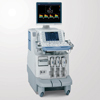Oregon Institute of Technology Acquires Toshiba Ultrasound Technology
by
Barbara Kram, Editor | November 12, 2008

Toshiba Artida 4D
ultrasound
TUSTIN, CA -- To offer its students access to the most advanced medical technology available, Oregon Institute of Technology (OIT) has acquired the Toshiba Aplio™ Artida 4D ultrasound system. The acquisition of the advanced ultrasound system will make OIT the first undergraduate program in the United States to offer courses in 4D ultrasound imaging.
"Our goal is to train OIT students using the newest, most advanced technology to prepare them for high-tech, high-demand careers in healthcare," explained OIT's Brad Burda, acting provost and interim dean, School of Health, Arts and Sciences. "By using the Artida, one of the most advanced 4D ultrasound systems available, our students will gain the comprehensive skills necessary to meet today's healthcare demands."
Using Artida's real-time, multi-planar reformatting capabilities, physicians can assess global and regional LV function, including volumetric LV ejection fraction. Arbitrary views of the heart, not available in 2D imaging, are also obtained to help with surgical planning. The 2D/3D wall motion tracking features from Toshiba allow the user to obtain angle-independent, global and regional information about myocardial contraction. It is hoped these features will enable acquisition of additional data that could be of value in echo-guided cardiac resynchronization therapy (CRT) and in stress echocardiography.
Artida includes additional features that enhance diagnostic capabilities, including multiple processors that run synchronously which allows for handling large amounts of data.
"Toshiba specifically designed the Artida to meet the needs of the growing 4D cardiac market," explained Gordon Parhar, director, Ultrasound Business Unit, Toshiba. "As the first ultrasound system in the world with the ability to track and display myocardial motion and 3D volumes in 3D images, OIT students will learn new imaging techniques that will set future healthcare standards."
Since the Artida's multiple processor design brings echocardiography to a new level of imaging performance and clarity, OIT plans to use the Artida 4D ultrasound system in its new Echocardiography program. The Artida employs the distributed processing power of more than 80 processor cores interconnected by a fast digital system interface. The Artida's engine is so powerful that every single second it can process an amount of data equal to a fully-loaded DVD.
MultiCast Beamformer
Artida's MultiCast Beamformer uses advanced digital signal processing to control the shape of the ultrasound beam more precisely and flexibly than in comparable systems. Notable performance improvements, such as a simultaneous multiple transmit focus or a doubled frame rate in color Doppler mode, help expedite exams while improving diagnostic accuracy.
